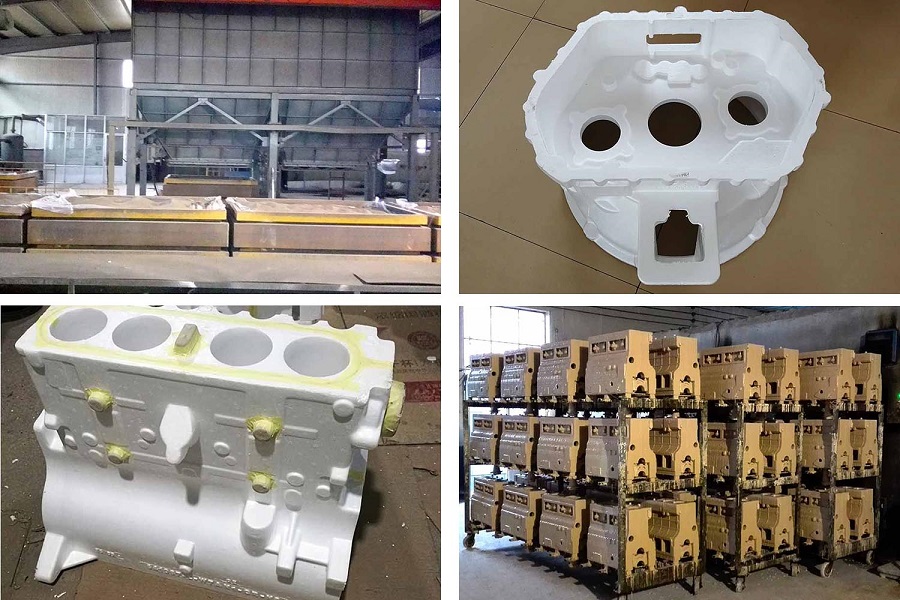
Full Mold Casting Foundry
Casting Process: Lost Foam Casting Metal: Cast Iron, Cast Steel. Application: Truck Spare Parts
Lost Foam Full Mold Casting Foundry from China with OEM Custom and CNC Machining Services. We are casting company offer dry sand casting process including lost foam and vacuum casting.
Lost Foam Full Mold Casting Foundry from China with OEM Custom and CNC Machining Services. We are casting company offer dry sand casting process including lost foam and vacuum casting.
Lost foam casting, also known as Full Mold Casting, Solid Mold Casting or Cavityless Molding Casting, is to bond and combine foam plastic patterns into pattern clusters. After coating refractory materials and drying, they are buried by the workers at lost foam casting foundry in dry silica sand for vibration molding and poured with molten metals under negative pressure. The foam patterns are vaporized, followed by the liquid metal occupies the pattern spaces, and the lost foam casting is formed after solidification and cooling. The lost foam casting does not require mold removal. At most lost foam casting foundries, the commonly used pattern material is polystyrene.
Lost foam casting is a near-net forming process, suitable for the production of more precise castings of various sizes with complex structures and unlimited alloys.
▶ What Metals and Alloy Can Be Poured by Lost Foam Casting (LFC):
• Cast Iron: Cast Gray Iron, Cast Ductile Iron, White Iron, Malleable Iron...etc.
• Aluminium and Its Alloys.
• Carbon Steel: Low carbon, medium carbon and high carbon steel from AISI 1020 to AISI 1060.
• Cast Steel Alloys: ZG20SiMn, ZG30SiMn, ZG30CrMo, ZG35CrMo, ZG35SiMn, ZG35CrMnSi, ZG40Mn, ZG40Cr, ZG42Cr, ZG42CrMo...etc on request.
• Stainless Steel: AISI 304, AISI 304L, AISI 316, AISI 316L and other stainless steel grade.
• Brass, Bronze and other Copper-based Alloys
• Other alloys as request or according to ASTM, DIN, GOST, GB...etc.
▶ What We Can Achieve by Lost Foam Casting:
• Max Size of Lost Foam Castings: 1,000 mm × 800 mm × 500 mm
• Weight Range of Lost Foam Castings: 0.5 kg - 100 kg
• Lost Foam Casting Annual Capacity: 2,000 tons
• Tolerance Grade of finished blank castings: CT5 ~ CT8 or on request.
▶ Steps of Lost Foam Casting Process:
During lost foam casting process, the sand is not bonded by adhensive materials, but a foam pattern is used to form the shape of the desired metal parts. The foam pattern is "invested" into the sand at the Fill & Compact process station allowing the sand into all voids and supporting the foam patterns external form.
Before making the foam patterns, the lost foam casting foundry should finish the process of pre-foam. The original beads are heated to above the softening point to quickly vaporize and expand the foaming agent, forcing the beads to reach the foaming density required by the foam template, and then quickly cool to stop the foaming of the foam beads and maintain the pre-expanded volume .
The general lost foam casting process are as in the following:
• Use foam molds to produce foam patterns and casting gating systems
• Bond the patterns and runners to form a mold bundle module
• Dip paint on the module with refractory materials
• Dry the paint
• Put the module into the sand box and fill it with dry sand
• Vibrate molding in order to fill the cavity with dry sand and then compact the molding sand
• Pouring molten metal to vaporize the foam and then forming the desired castings
• After the castings have cooled, clean the castings. The dry sand can be recycled
▶ Advantages of Lost Foam Casting Process:
1- Lost foam casting is a near-net shape casting method. The dimensional tolerance of the casting can reach CT6~CT9, and the surface roughness is Ra=6.3~50 μm. The shape of lost foam castings can be comparable to resin sand castings.
2- Lost foam casting can produce castings with complex shapes and complex cavities. Compared with the resin sand process, the more sand cores are replaced, the greater the profit margin of lost foam casting. The core competitiveness of lost foam casting is the production of difficult castings with complex inner cavities, such as engine block, engine head and box, etc. These characteristics make the superiority and economic benefits of lost foam casting fully appear, and realize the lightweight and precise casting.
3- Lost foam casting does not require mold removal, which provides greater freedom for casting design and casting process. In terms of process design, the lost foam casting process is first broken into parts and then spliced into a whole, and then the lost foam process is used for integral casting, so that the lost foam casting has the competitive advantage with the traditional sand casting.
4- The use of lost foam casting process can greatly reduce labor intensity, reduce the generation of solid waste, and the used dry sand can be recycled. This feature meets the requirements of energy saving and emission reduction, and has changed the harsh environment of traditional sand casting.
▶ How We Inespect the Lost Foam Castings
• Spectrographic and manual quantitative analysis
• Metallographic analysis
• Brinell, Rockwell and Vickers hardness inspection
• Mechanical property analysis
• Low and normal temperature impact testing
• Cleanliness inspection
• UT, MT and RT inspection
▶ What We Can Do after Lost Foam Casting:
• Deburring & Cleaning
• Shot Blasting / Sand Peening
• Heat Treatment: Normalization, Quench, Tempering, Carburization, Nitriding
• Surface Treatment: Passivation, Andonizing, Electroplating, Hot Zinc Plating, Zinc Plating, Nickel Plating, Polishing, Electro-Polishing, Painting, GeoMet, Zintec.
• Machining: Turning, Milling, Lathing, Drilling, Honing, Grinding.

 русский
русский



